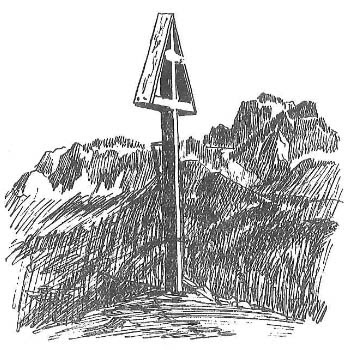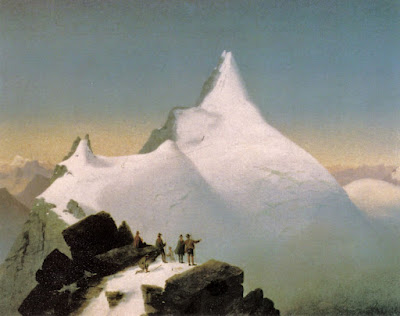As the debate over the meaning of C D Friedrich’s summit cross paintings showed, symbols have multiple meanings, depending on who interprets them. Those paintings also contributed “not a little” to popularising the idea of summit crosses, says cultural historian, Martin Scharfe. We may doubt, however, whether they contributed much to the population of actual summit crosses. According to Scharfe himself, no more than half a dozen appeared on high alpine peaks during the artist’s lifetime.
 |
| Summit cross on the Gross Ruchen, Urner Alps |
For peak-baggers who might want to visit their locations, these early summit crosses were set up on the Vincent Pyramid (1819) and the Zumsteinspitze (1820), both in the Monte Rosa massif, the Ankogel in the Hohe Tauern (1822), the Sonnwendjoch in Rofan (1823), and on the Dachstein (1834). In the same year, Swiss climbers put one on the Altels, a mountain in the Bernese Oberland.
 |
| To the summit of Clariden, April |
 |
| Piz Terri, club outing, July |
 |
| Austrian mountain guides rescue the Grossglockner cross in 2010 Photo: Bergrettung AT - www.bergrettung.at/ |
Bending to the anti-imperial sentiment of the times, the Austrian Alpine Club re-dedicated the cross as a war memorial. For the mood had indeed changed. Writing in 1928, Eugen Guido Lammer, a “high priest of guideless and solo climbing”, asked “What has the cross to tell us in midst of the mountain wilderness – this memento of the worst judicial murder of all times? Just let the voice of the elements sound clearly so that Nature can speak to you in her authentic voice.”
 |
| Summit cross, Rigi |
 |
| Summit cross on the Lagginhorn, Valais Alps |
Extreme climbers, then as now, may not be fully representative of their age. For the fact is that many new summit crosses made their appearance after the two world wars, at least if those Tyrolean statistics are to be believed. Most were set up by local communities or mountaineering clubs, often as memorials to a village’s war dead, or victims of a mountaineering accident.
One might take as an example the crosses that used to adorn the Schafreuter (2,102 metres), in the Karwendel range that runs along the Austrian/Bavarian border. The mountain’s first one, an oaken cross standing eight metres high, was put up towards the end of July 1926 by the local alpine club. It was dedicated to the memory of alpinists from Bavaria and the Tyrol who had fallen during the war.
In October 1951, the old cross was replaced by a new one, half as high. Again, it was the local alpine club, represented by its youth section, who took the initiative. Pater Volker, who officiated over the inauguration, said the cross on the summit symbolised eternity and, together with his congregation prayed for world peace, and for the souls of all Germans and Austrians who would never come home after the war.
 |
| The Schafreuter summit cross, after the hacking attack (Photo: Alpenverein Tölz/Die Welt) |
There’s a strange twist to the Schafreuter story. The local mountaineering club – the same that set up the original crosses after the two world wars – was quick to promise that it would bring up a replacement next year. But they have been forestalled. Just one week after the axeman’s visit, a group of anonymous young men brought up a makeshift replacement cross and set it in place. According to the Süddeutsche Zeitung, they were wearing t-shirts that associate them with a right-wing nationalist group.
 |
| Summit cross on Vorderglärnisch, Glarus Alps |
Standing somewhat aloof from European affairs, Switzerland’s recent history and politics have been less volatile than those of its neighbours. By the same token, its summit crosses have generally stirred up less controversy. There is even a foundation, Croix aux sommets, that pays for new crosses to be set up. But the ruckus in 2010, not to mention the Patrick Bussard case, shows that the cross-currents swirling round the country’s otherwise serene peaks are not, in essence, so different to those that beset nearby regions.
 |
| Belayed to the cross, Matterhorn |
 |
| Summit symbolism |
References
Daniel Anker, „Das Kreuz mit dem Kreuz“, Die Alpen, 4/2012
Wilhelm Eppacher, Berg- und Gipfelkreuze in Tirol
Martin Scharfe, Berg-Sucht : eine Kulturgeschichte des frühen Alpinismus 1750-1850
Norbert Wolf, Caspar David Friedrich : 1774-1840 : der Maler der Stille, Taschen















